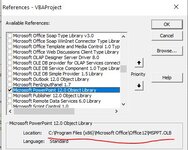For example when you make the application, you have to use the application's name in the datatype:
Dim App As PowerPoint.Application
Set App = New PowerPoint.Application
But here not:
Dim Pres As Presentation 'why not PowerPoint.Presentation
How will VBA know if that datatype belongs to whom?
Let's say Word and Excel has a Range object, how will VBA know which range I mean, if i don't specifiy? Or these same named objects can be used in all office programs without specifiing the app, since they mean the same?
Thank you very much for your idea, have a nice day
Dim App As PowerPoint.Application
Set App = New PowerPoint.Application
But here not:
Dim Pres As Presentation 'why not PowerPoint.Presentation
How will VBA know if that datatype belongs to whom?
Let's say Word and Excel has a Range object, how will VBA know which range I mean, if i don't specifiy? Or these same named objects can be used in all office programs without specifiing the app, since they mean the same?
Thank you very much for your idea, have a nice day






